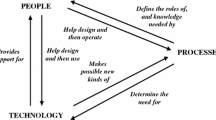Abstract
The design of medical knowledge-based computer systems requires effective interdisciplinary communication for the development of a community sharing common goals and a common language for design. Over the past 9 years the Perinatal Research Group, an interdisciplinary team of computer scientists, engineers and clinicians, have developed a prototype knowledge-based computer system to aid clinicians in the care of women in labour. The group were uncertain which approach to adopt to progress this system from a prototype to a useful clinical tool to support decision making. A case study and activity theory analysis, of an existing clinical knowledge-based computer system in routine use, helped to resolve a number of communication and methodological issues that the design team encountered. Sharing of backgrounds and perspectives caused the design team to question previous assumptions and to explore alternative functions and roles for knowledge-based computer systems in maternity care. We are now undertaking a longitudinal case study and activity theory analysis of obstetric teams and women in labour to analyse the relationships between clinicians, patients and technology. This work will inform the development of our knowledge-based computer system to place the patient at the centre of the decision-making process.
Similar content being viewed by others
Explore related subjects
Discover the latest articles and news from researchers in related subjects, suggested using machine learning.References
Audit Commission (1995). For your Information: A Study of Information Management and Systems in the Acute Hospital. HMSO, London.
Berg, M. (1997). Formal Tools and Medical Practices: Getting Computer-Based Decision Techniques to Work. In G.C. Bowker, S.L. Star, W. Turner and L. Gasser (eds)Social Science, Technical Systems and Cooperative Work; Beyond the Great Divide. Erlbaum, Hillsdale, NJ. 301–330.
Broadbent, D.E. (1990). Effective Decisions and their Verbal Justification,Philosophical Transactions of the Royal Society of London: Biological Sciences.327. 493–502.
Brown, S. and Lumley, J. (1998). Changing Childbirth: Lessons from an Australian Survey of 1336 Women,British Journal of Obstetrics and Gynaecology.105, 143–155.
Carroll, J.M. (1997). Human-Computer Interaction: Psychology as a Science of Design,Annual Review of Psychology,48. 61–83.
Checkland, P. (1981). Systems Thinking, Systems Practice. Wiley, Chichester.
Engestrom, Y. (1991). Developmental Work Research: Reconstructing Expertise Through Expansive Learning. In M. Nurminen and G. Weir (eds)Human Jobs and Computer Interfaces. Amsterdam, Elsevier. 265–290.
Hannah, K.J. and Osis, M. (1988). Computers and Staff Development. In M.J. Ball, K.J. Hannah, H.G. Jelger and H. Peterson (eds)Nursing Informatics. Springer, New York, 321–328.
Hughes, J.A., Sommerville, I., Bentley, R. and Randall, D. (1993). Designing with Ethnography: Making Work Visible,Interacting with Computers.5(2). 239–253.
Hutchins, E. (1990). The Technology of Team Navigation. In J. Galagher (ed.)Intellectual Teamwork. Erlbaum, Hillsdale, NJ. 191–220.
Kaplan, B. and Duchon, D. (1988). Combining Qualitative and Quantitative Methods in Information Systems Research: A Case Study,MIS Quarterly. 571–586.
Keith, R.D.F., Westgate, J., Ifeachor, E.C. and Greene, K.R. (1994a). Suitability of Artificial Neural Networks for Feature Extraction from the Cardiotocogram During Labour.Medical and Biological Engineering and Computing: Electrocardiography, Myocardial Contraction and Blood Flow Supplement.32, S51-S57.
Keith, R.D.F., Westgate, J., Hughes, G.W., Ifeachor, E.C. and Greene, K.R. (1994b). Preliminary Evaluation of an Intelligent System for the Management of Labour.Journal of Perinatal Medicine.22. 345–350.
Keith, R.D.F., Beckley, S., Garibaldi, J.M., et al. (1995). A Multicentre Comparative Study of 17 Experts and an Intelligent Computer System for Managing Labour Using the Cardiotocogram,British Journal of Obstetrics & Gynaecology.102. 688–700.
Mays, N. and Pope, C. (1995). Rigour and Qualitative Research,British Medical Journal.311(6997). 109–112.
Monk, A.F. and Gilbert, N. (1995). Inter-disciplinary Research. In A.F. Monk and N. Gilbert (eds)Perspectives on Human-Computer Interaction: Diverse Approaches. Academic Press, Cambridge, UK.
Moray, N. (1994). Error Reduction as a Systems Problem. In M.S. Bogner (ed.)Human Error in Medicine. Erlbaum, Hillsdale, NJ.
Nardi, B. (1996). Context and Consciousness. Activity Theory and Human Computer Interaction. MIT Press, London.
Norman, D. (1993). Things that Make Us Smart: Defending Human Attributes in the Age of the Machine. Addison-Wesley, Reading, MA.
Pettigrew, A. (1990). Longitudinal Field Research on Change Theory and Practice,Organisational Science.1(3). 267–292.
Platt, J. (1992). ‘Case Study’ in American Methodological Thought,Current Sociology.40, 17–48.
Reason, J. (1995). Understanding Adverse Events: Human Factors In C. Vincent (ed.)Clinical Risk Management. BMJ Publishing Group, London.
Rogers, Y. and Ellis, J. (1994). Distributed Cognition: An Alternative Framework for Analysing and Explaining Collaborative Working,Journal of Information Technology.9, 119–128.
Skinner, J., Harris, M. and Greene, K.R. (1998a). Computerised Decision Support for Managing Labour Using the Cardiotocogram: 500 Cases with the Range of Abnormality,British Journal of Obstetrics & Gynaecology.105(S 17). 27.
Skinner, J., Harris, M., Keith, R.D.F., and Greene, K.R. (1998b). Computerised Decision Support for Managing Labour Using the Cardiotocogram: 900 Serial High Risk Cases,British Journal of Obstetrics & Gynaecology.105(S 17). 82–83.
Suchman, L. (1987). Plans and Situated Actions: The Problem of Human-Machine Communication. Cambridge University Press, New York.
Walsham, G. (1993). Interpreting Information Systems in Organisations. Wiley, Chichester.
Westgate, J., Garibaldi, J.M. and Greene, K.R. (1994). Umbilical Cord Blood Gas Analysis at Delivery: A Time for Quality Data,British Journal of Obstetrics & Gynaecology.101. 1054–1063.
Author information
Authors and Affiliations
Corresponding author
Rights and permissions
About this article
Cite this article
Harris, M., Jagodzinski, A.P. & Greene, K.R. Roles for knowledge-based computer systems: Case studies in maternity care. AI & Soc 15, 386–395 (2001). https://doi.org/10.1007/BF01206117
Issue Date:
DOI: https://doi.org/10.1007/BF01206117




